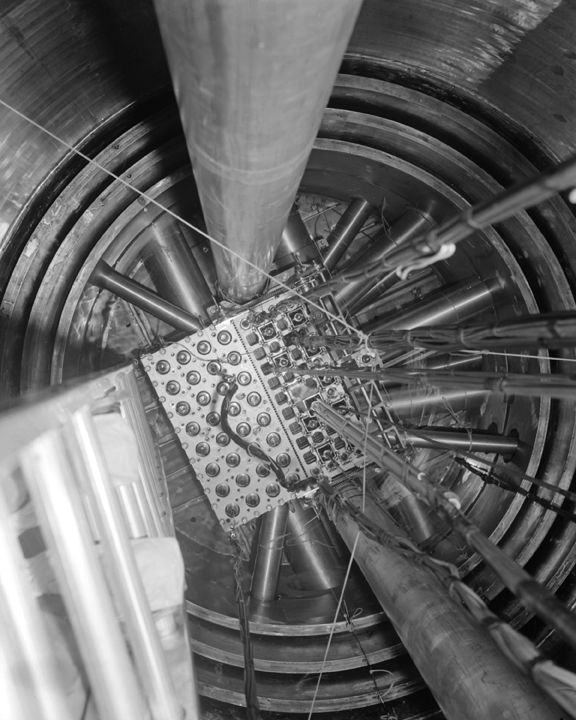Space History Photo: Reactor Core Area

In this historical photo from the U.S. space agency, the Plum Brook Facility reactor core area as seen from the top of the pressure tank in 1961.
The reactor core (right side of the box) comprises a uranium-fueled section (a center array of three hole by nine holes for fuel control rods) surrounded by reflector material or experiments, to compose the complete four-by-eleven hole core array. The fueled core contains twenty-two stationary rods and five movable cadmium and fuel control rods.
The reflector material on three sides includes two cadmium and beryllium movable regulating rods, three similar shim safety rods, and twelve fixed reflector plugs or experiments. The fueled core housing has reflector plates on the right and left sides and aluminum end-plates. Along side the fueled section is a large four-by-eight hole reflector section(left side of the box), which provides facilities for inserting up to thirty-two experiments, one for each hole.
The whole core structure sits on a stainless steel rack in the stainless-steel-lined pressure vessel (nine feet in diameter by thirty-one feet high). Three thermal shields are visible (the three rings) around the core. Two large vertical test holes run next to the end of the cores. One large tube runs through the large reflector section and another runs next to the fueled section. Three smaller beam tubes about the right side of the core and three others are on the reflector side (left).
For more information browse the Plum Brook Facility Page.
Each weekday, SPACE.com looks back at the history of spaceflight through photos (archive).
Get the Space.com Newsletter
Breaking space news, the latest updates on rocket launches, skywatching events and more!
Join our Space Forums to keep talking space on the latest missions, night sky and more! And if you have a news tip, correction or comment, let us know at: community@space.com.

The National Aeronautics and Space Administration (NASA) is the U.S. government agency in charge of the civilian space program as well as aeronautics and aerospace research. Founded in 1958, NASA is a civilian space agency aimed at exploring the universe with space telescopes, satellites, robotic spacecraft, astronauts and more. The space agency has 10 major centers based across the U.S. and launches robotic and crewed missions from the Kennedy Space Center in Cape Canaveral Florida. It's astronaut corps is based at the Johnson Space Center in Houston. To follow NASA's latest mission, follow the space agency on Twitter or any other social channel, of visit: nasa.gov.









